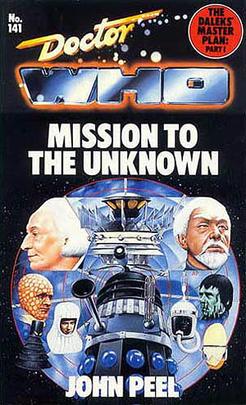| 019 –"Mission to the Unknown" | |||
|---|---|---|---|
| Doctor Who episode | |||
 | |||
| Cast | |||
Starring
| |||
| Production | |||
| Directed by | Derek Martinus | ||
| Written by | Terry Nation | ||
| Script editor | Donald Tosh | ||
| Produced by | Verity Lambert | ||
| Music by | Trevor Duncan [b] | ||
| Production code |
| ||
| Series | Season 3 | ||
| Running time | 25 minutes | ||
| Episode(s) missing | 1 episode | ||
| First broadcast | 9 October 1965 | ||
| Chronology | |||
| |||
"Mission to the Unknown" [d] is the second serial of the third season of the British science fiction television series Doctor Who . Written by Terry Nation and directed by Derek Martinus, the single episode was broadcast on BBC1 on 9 October 1965. The only standalone regular episode of the show's original run, [e] it serves as an introduction to the 12-part story The Daleks' Master Plan . It is notable for the complete absence of the regular cast and the TARDIS; it is the only serial in the show's history not to feature the Doctor at all. The story focuses on Space Security Agent Marc Cory (Edward de Souza) and his attempts to warn Earth of the Daleks' plan to take over the Solar System.
Contents
- Plot
- Production
- Conception and writing
- Casting and filming
- Reception
- Broadcast and ratings
- Critical response
- Commercial releases
- Recreation
- Production 2
- Release and reception
- Notes
- References
- Bibliography
- External links
After the show's second production block was granted an additional episode, outgoing story editor Dennis Spooner commissioned Nation to write an extra episode as a cutaway to set up The Daleks' Master Plan. Nation wrote the episode while considering a Dalek-focused spin-off; he used film character James Bond as inspiration for Marc Cory. "Mission to the Unknown" was produced by the same team as its predecessor, Galaxy 4 , in a five-week period that concluded the show's second production block; the two serials were held back to open the third season. Failing health prevented original director Mervyn Pinfield from continuing, replaced by Martinus. Production took place at the Television Centre in August 1965.
"Mission to the Unknown" received 8.3 million viewers, a drop from the previous serial. Contemporary and retrospective reviews were generally positive, with praise for the script and direction, though some viewers were confused that the following serial did not immediately continue the narrative. The videotapes of the episode were wiped by the BBC in July 1974, and it remains missing with no remaining footage. Usually alongside The Daleks' Master Plan, "Mission to the Unknown" received print and audiobook adaptations, with off-air recordings used to construct the latter. In 2019, director Andrew Ireland and University of Central Lancashire students recreated the episode in live-action, replicating the 1960s production values.


